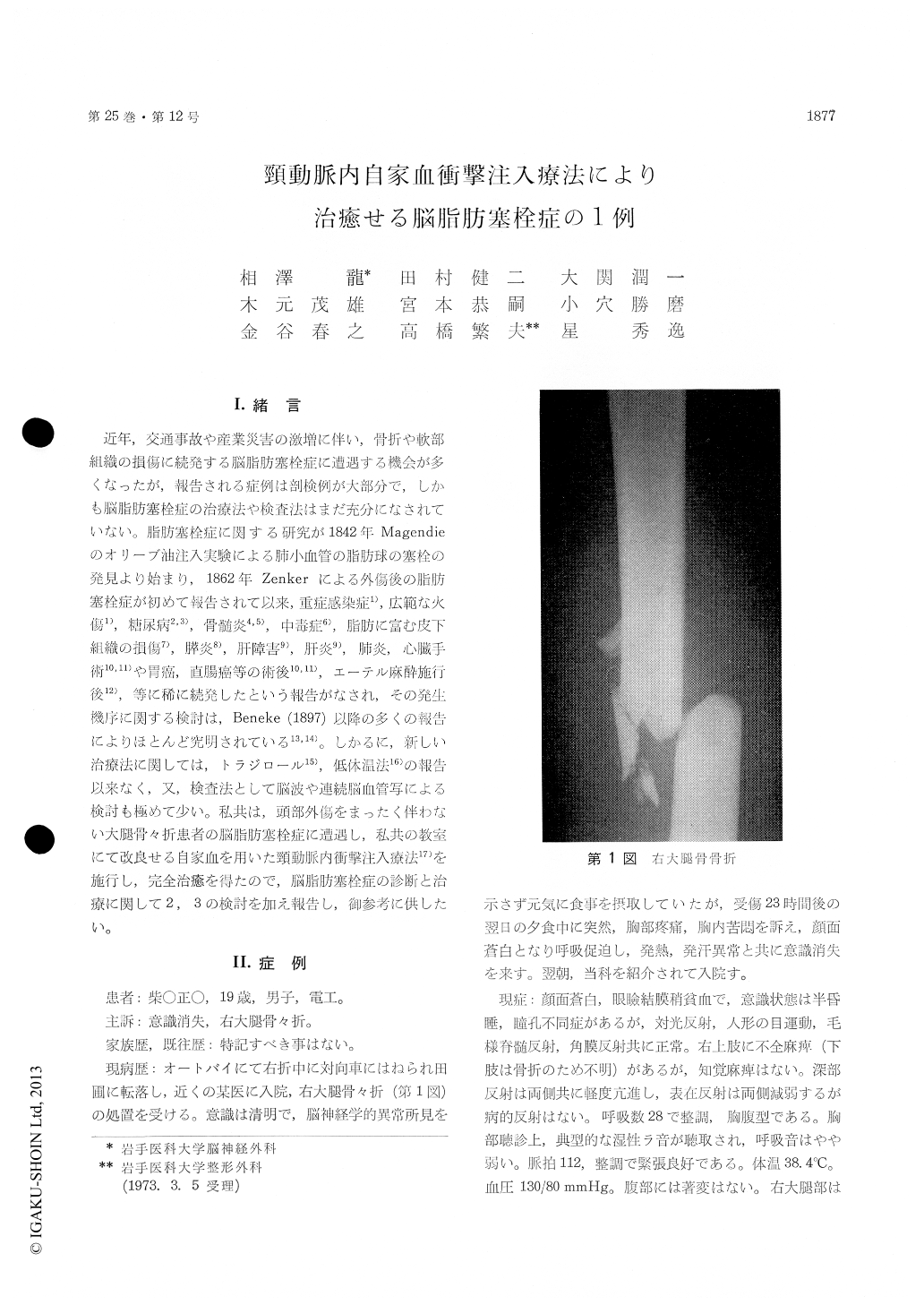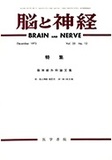Japanese
English
- 有料閲覧
- Abstract 文献概要
- 1ページ目 Look Inside
I.緒言
近年,交通事故や産業災害の激増に伴い,骨折や軟部細織の損傷に続発する脳脂肪塞栓症に遭遇する機会が多くなったが,報告される症例は剖検例が大部分で,しかも脳脂肪塞栓症の治療法や検査法はまだ充分になされていない。脂肪塞栓症に関する研究が1842年Magendieのオリーブ油注入実験による肺小血管の脂肪球の塞栓の発見より始まり,1862年Zenkerによる外傷後の脂肪塞栓症が初めて報告されて以来,重症感染症1),広範な火傷1),糖尿病2,3),骨髄炎4,5),中毒症6),脂肪に富む皮下組織の損傷7),膵炎8),肝障害9),肝炎9),肺炎,心臓手術10,11)や胃癌,直腸癌等の術後10,11),エーテル麻酔施行後12),等に稀に続発したという報告がなされ,その発生機序に関する検討は,Beneke (1897)以降の多くの報告によりほとんど究明されている13,14)。しかるに,新しい治療法に関しては,トラジロール15),低体温法16)の報告以来なく,又,検査法として脳波や連続脳血管写による検討も極めて少い。私共は,頭部外傷をまったく伴わない大腿骨々折患者の脳脂肪塞栓症に遭遇し,私共の教室にて改良せる自家血を用いた頸動脈内衝撃注入療法17)を施行し,完全治癒を得たので,脳脂肪塞栓瘍血症の診断と治療に関して2,3の検討を加え報告し,御参考に供したい。
Systemic cerebral fat embolism following trauma without head injury has been known as a clinical entity for the last 100 years. As to the treatment, however, administration of low molecular weight dextran, trasylol, and heparin in sub-anticoagula-tion doses, and application of hypothermia have been used with little success.
Recently, the authors treated a case of systemic fat embolism by using impact therapy with auto-blood containing citrate pumped into the common carotid artery. A 19-year-old boy had been involvedin a traffic accident on September 26, 1970. When he was first seen by a general surgeon, he was conscious but a closed fracture of the right femoral bone was noted. Twenty-three hours after the accident, he began to complain of oppression and pain in the chest. Then he became pale and de-veloped fever and profuse sweating followed by loss of consciousness. On admission to our hospital the next day, examination revealed semi-comatose, anisocoria (L>R), yellow-white fleck in the optic fundi, right hemiparesis, and petichial skin rash on the chest and the shoulders. A chest X-ray film demonstrated a characteristic "snow storm pattern". Examination of sputa revealed fat droplets. An EEG taken one week after the accident showed diffuse slow wave pattern. Bilateral carotid angio-graphy demonstrated early venous filling and pro-longed filling of the middle cerebral artery.
Because the patient's general and neurological condition remained unchanged one week after the accident, impact therapy was tried. 18.5ml. of autoblood mixed with 1.5ml. of citrate was pumped into the common carotid artery. This procedure was repeated 20 times. Within one week after the impact therapy, the patient's consciousness had become clear and neurological signs had all disap-peared. EEG and carotid angiography six weeks after the accident showed no abnormal findings.
From our experience, it may be considered that impact therapy with autoblood in an effective treatment for fat embolism and is worth trying for the patient.

Copyright © 1973, Igaku-Shoin Ltd. All rights reserved.


